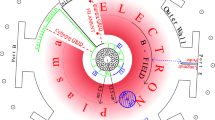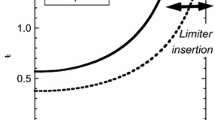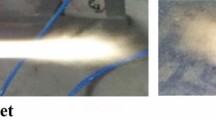Abstract
In a current-less toroidal device (CTD), the vertical electric field produced by separation of charge particles due to gradient and curvature of the toroidal field tends to induce rapid radial transport of plasma. Thus, the plasma properties may be expected to depend strongly on reducing or minimizing this residual vertical electric field. In a current-less toroidal device, the parallel connection length \({\bar{L}}_c\) provides a pathway for electrons along the direction of the toroidal magnetic field, to reduce the charge separation induced by the gradient and curvature drifts of toroidal field. Hence, \({\bar{L}}_c\) can be expected to strongly influence both the quasi-static equilibrium and fluctuations in a current-less toroidal device. In an earlier work (Kumar et al. in Phys Plasmas 23:102301, 2016), the role of \({\bar{L}}_c\) was experimentally investigated for a given toroidal field strength (\(B_T\)) by varying the vertical magnetic field (\(B_v\)). However, \({\bar{L}}_c\) is known to be dependent on both \(B_v\) and \(B_T\). In the present work, we present the experimental results on the effect of variation in mean parallel connection length \({\bar{L}}_c\), on plasma properties, by simultaneously varying toroidal and vertical magnetic field. It has been observed that the loss of plasma density on the outboard side reduces for shorter \({\bar{L}}_c\). As \({\bar{L}}_c\) also determines the minimum parallel wavenumber, \(k_{||}^{min}\), the nature of fluctuations is found to change significantly with \({\bar{L}}_c\). For example, it is shown that for large values of \({\bar{L}}_c\), there are only a few dominant modes followed by turbulent fluctuations, whereas for shorter \({\bar{L}}_c\) values, there exist broadband leading to the turbulent fluctuation. As the nature of equilibrium and fluctuation varies with \({\bar{L}}_c\), the profile of poloidal flows also shows a strong dependence on \({\bar{L}}_c\), particularly for shorter \({\bar{L}}_c\), where net poloidal flow reduces significantly on the inboard side. Experiments for a given value of \({\bar{L}}_c\) (small, intermediate and large) performed for three different ratios of (\(B_v\), \(B_T\)) pairs clearly demonstrate the importance of \({\bar{L}}_c\) in the confinement and stability of the plasma in a CTD.












Similar content being viewed by others
References
A Fasoli, B Labit, M McGrath, S H Mueller, G Plyushchev, M Podesta, and F M Poli Phys. Plasmas13, 055902 (2006)
K Rypdal, E Gronvoll, F Oynes, A Fredriksen, R J Armstrong, and J Trulsen Plasma Phys. Controlled Fusion36, 1099 (1994)
C Riccardi, D Xuantong, M Salierno, L Gamberale, Phys. Plasmas4, 3749 (1997)
J C Perez and W Horton Phys. Plasmas13, 032101 (2006)
S Nishi, T Sakabe, M Uchida, H Tanaka, Plasma Phys. Controll. Fusion52, 065011 (2010a)
S Nishi, T Sakabe, M Uchida, H Tanaka, and T Maekawa Plasma Phys. Controll. Fusion52, 125004 (2010b)
S H Muller, A Fasoli, B Labit, M McGrath, M Podesta, and F M Poli Phys. Rev. Lett.93, 16 (2004)
S H Muller, A Fasoli, B Labit, M McGrath, O Pisaturo, M Podesta, and F M Poli Phys. Plasmas12, 090906 (2005)
F M Poli, P Ricci, A Fasoli, and M Podesta Phys. Plasmas15, 032104 (2008)
T S Goud, R Ganesh, Y C Saxena, D Raju, K Sathyanarayana, K K Mohandas, and C Chavda Phys. Plasmas18, 042310 (2011)
P K Sharma and D Bora Plasma Phys. Controll. Fusion37, 1003 (1995)
T S Goud, R Ganesh, Y C Saxena, and D Raju Phys. Phys. Plasmas20, 072308 (2013)
T S Goud, R Ganesh, Y C Saxena, and D Raju Phys. Plasmas19, 072306 (2012a)
S Yoshikawa, W Harries and R M Sinclair,Phys. Fluids06, 1506 (1963)
S Mahajan, R Singh, and K Avinash Phys. Plasmas4, 2612 (1997)
S Nakao, K Ogura, Y Terumichi, and S Tanaka Phys. Lett. A96A, 405 (1983)
U Kumar, S G Thatipamula, R Ganesh, Y C Saxena, and D Raju Phys. Plasmas23, 102301 (2016)
S G Thatipamula, U K Shukla, R Ganesh, Y C Saxena, and D Raju Rev. Sci. Instrum.86, 033504 (2015)
T S Goud, R Ganesh, Y C Saxena, D Raju, K Sathyanarayana, K K Mohandas, and C Chavda Phys. Plasmas19, 032307 (2012b)
S J Sackett EFFI: A code for calculating the electromagnetic field, force, and inductance in coil systems of arbitrary geometry, Tech. Rep. (1978)
T S Goud, R Ganesh, K Sathyanarayana, D Raju, K K Mohandas, , A M Thakar, and N C Patel J. Phys.208, 012029 (2010)
U Kumar Ph.D. thesis, Institute for Plasma Research (HBNI), Gandhinagar (2018)
I H Hutchinson, Principle of Plasma Diagnostics, 2nd ed. (Cambridge University Press, Reading, 1987)
J M Beall, Y C Kim, and E J Powers J. Appl. Phys.52, 3933 (1982)
D Jassby, Phys. Fluids15, 1590 (1972)
C Riccardi and A Fredriksen Phys. Plasmas8, 199 (2001)
S Mahajan Ph.D. thesis, Institute for Plasma Research, Gandhinagar (1997)
Y C Kim and E J Powers, IEEE Transaction on Plasma SciencePS-7, No. 2 (1979)
E J Powers, Nucl. Fusion14, 5 (1974)
Acknowledgements
Authors would like to thank Deep Vadher for his technical helps during designing and performing the experiments. Authors would also like to thank Sharvil Patel for perfoming detailed measurements of the co-ordinates of TF coils and Richa Bandyopadhyay for carrying out the extensive simulation of toroidal field lines shown in Fig. 1.
Author information
Authors and Affiliations
Corresponding author
Additional information
Publisher's Note
Springer Nature remains neutral with regard to jurisdictional claims in published maps and institutional affiliations.
Rights and permissions
About this article
Cite this article
Kumar, U., Ganesh, R., Saxena, Y.C. et al. Effect of parallel connection length on the properties of a low-temperature plasma confined in a current-less toroidal device. Indian J Phys 95, 989–1002 (2021). https://doi.org/10.1007/s12648-020-01767-7
Received:
Accepted:
Published:
Issue Date:
DOI: https://doi.org/10.1007/s12648-020-01767-7




